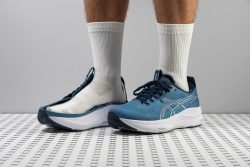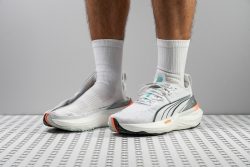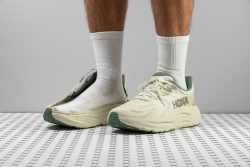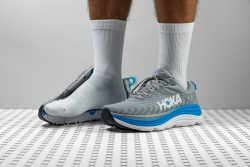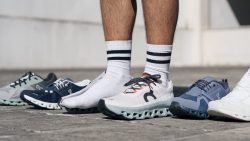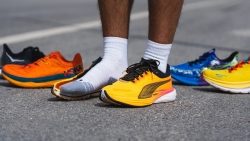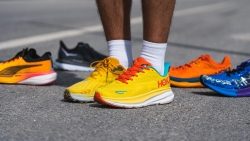7 Best Running Shoes For Low Arches in 2025

We buy shoes ourselves. We earn commissions when you buy through us, at no extra cost. Why trust us
Equipped with our shoe testing lab and our dedicated staff of testers, we’ve tested and looked for the best stability tech, arch support, and motion control design to highlight our top picks among the best shoes for runners with low arches.
Depending on your specific needs, we’ve selected our best picks in different categories. Check them out here!
How we test running shoes for low arches
As a team of experienced runners, we constantly test the latest offerings in the low-arch running shoe category. Each pair of shoes is lab-tested and wear-tested. The entire process of reviewing shoes includes these steps:
- Buying all the running shoes on this list with our own money. We follow this to keep everything transparent, honest, and unbiased.
- Cutting the shoes into pieces in our lab. This allows us to get a much closer look at the parts and techs.
- Weighing and measuring 20+ parameters, including energy return, stability, heel counter stiffness, platform width, and many others. We also compare the measurements and scores to the average values for running shoes.
- Wear-testing the shoe in various training conditions and paces.
Best running shoes for low arches overall
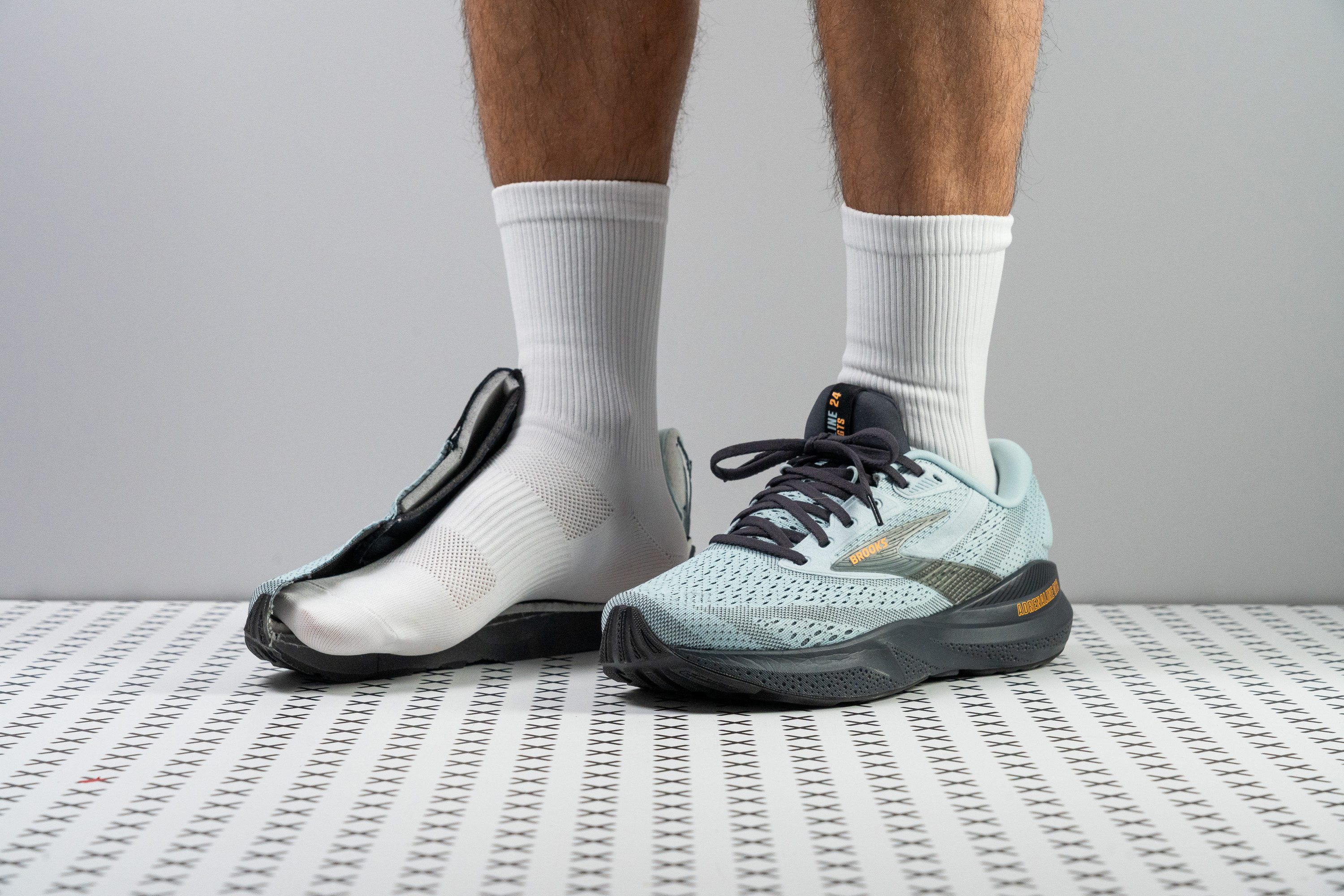
















































What makes it the best?
In our runs, Adrenaline GTS 24 kept our arches supported while making sure we remained comfortable. Despite being a stable shoe, it doesn’t force us to run in a particular way. Our lab results and runs show it has a good balance of stiff and flexible elements for low-key support—making it our top running shoe for low arches.
The cushion feels firm yet thick enough for protected landings. Our durometer confirms it’s a balanced 25.1 HA, which delivers a steady and springy ride. Meanwhile, our caliper shows the heel is 39.0 mm tall.
With a wider-than-average rear, it ensures a securely planted sensation. Further promoting steady landings is its GuideRails technology, which is integrated into the sides of the shoe to prevent excess movement. It also includes a medial post to reinforce our arches.
Steady support is given most naturally thanks to its adaptive midsole. In our flex test, it boldly exceeds the average by 19.9%. This elevates comfort to the next level since it blocks off any fighting sensation from the midsole.
We warn caution that this shoe has an aggressive offset that’s only suited for rear strikers. We recommend mid-to-forefoot strikers to find a pair that complements their running dynamics.
Pros
- Stack height upgrade!
- Reliable support
- Breathable mesh with oversized vents
- Price remains unchanged
- Available in 4 width options
- Good durability
- Plush tongue for top comfort
- Ideal for heel strikers
- Foam upgrade to DNA Loft v3
Cons
- Firmer-than-expected midsole
- High drop may feel too steep
- Toebox height is a bit low
- Non-gusseted tongue
Running shoes for low arches with the best shock absorption














































What makes it the best?
The 32nd iteration of Gel Kayano is our recommendation for the best shock-absorbing low-arch running shoe. This daily trainer delivers the best of both worlds in comfort and support with its ultra-stacked and plushly-packed cushion and 4D Guidance System. It delivers a cushioned ride in a sure-footed manner, which often isn’t the case for maximalist shoes.
Rising to 39.9/30.6 mm, GK32’s skyscraper stack sits well above the average for added comfort. The cherry on the top is the cloudlike touch we felt with every stride. Our shock absorption test reveals a high rating of 133 SA in the heel and 116 SA in the forefoot. This combo feels so luxurious that we could handle long miles without feeling tired.
GK32 proves a maximalist can be steady through its revolutionary 4D Guidance System and its wide platform—the main ingredients to its stable ride. The arch support adjusts to each foot shape for custom protection. The midsole is insanely spacious and can accommodate even the widest feet, measuring 119.8/97.2 mm in the forefoot and heel. That’s an extra 5.5/6.5 mm more than average!
As expected, this wide and padded shoe can use a diet with its 10.4 oz (295g) weight. Not everyone needs a maximalist shoe. Other athletes may check lighter options.
Pros
- Amazing shock absorption
- Plush and breathable upper
- Made to last
- Dependable for most pronators
- Heavy-duty outsole with excellent grip
- Stable as a table
- Pillow-soft heel padding
- Improved fit
- Excellent build quality
Cons
- Not for soft-foam lovers
- Bad energy return
- Overpriced in Europe
Running shoes for low arches with the best energy return
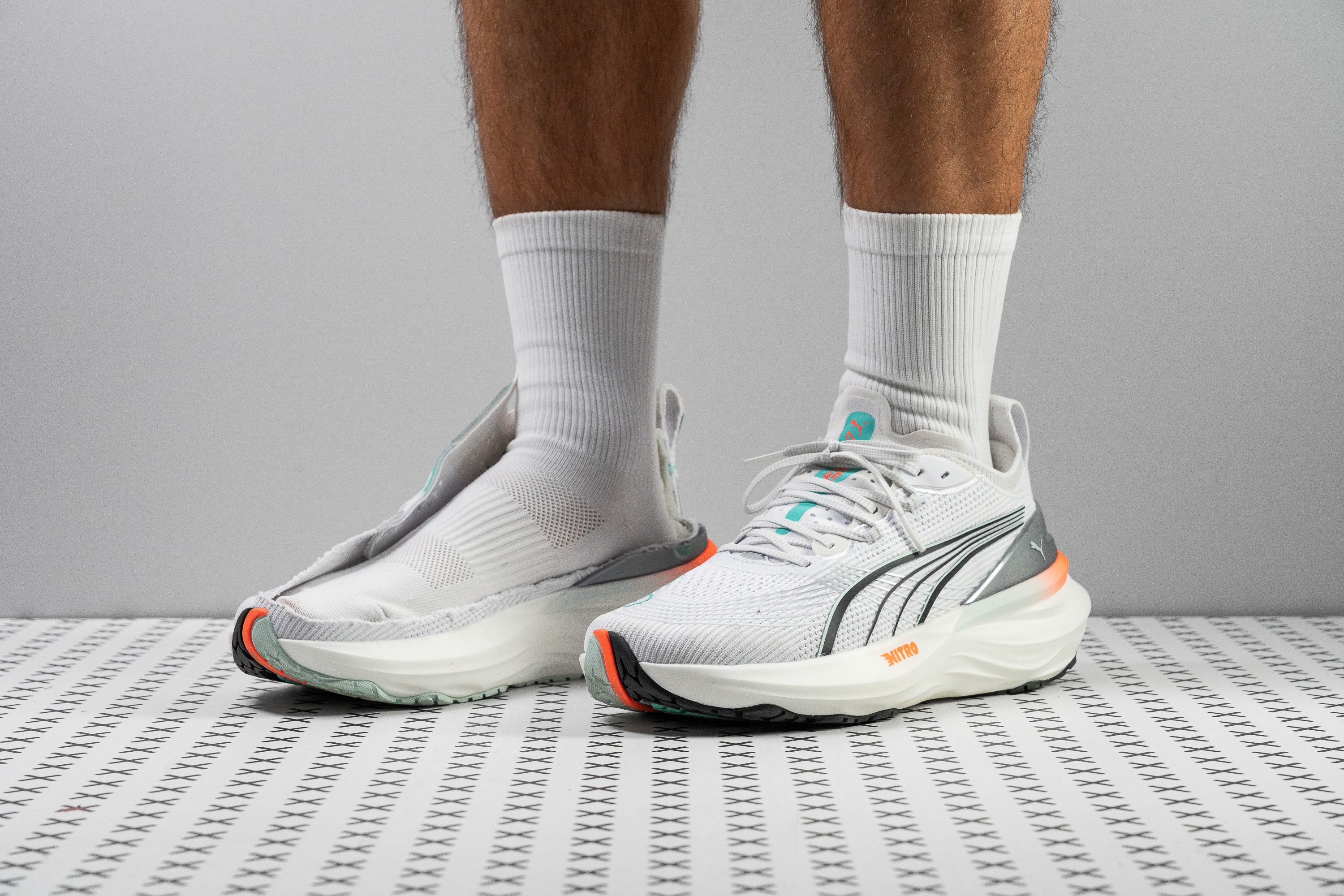











































What makes it the best?
PUMA ForeverRun Nitro 2 is unlike any other, bringing a fresh approach to arch support, speed, and stability. Other than its wide base and Run Guide System, this stability shoe surprises us with its soft, springy midsole in lab tests. It provides the guidance and speed needed for any distance, making it our low-arch running shoe with the best energy return.
The cushion is bouncy and keeps our momentum strong. We tested the Nitro foam in the lab and recorded remarkable energy return scores of 60.5% in the heel and 63.6% in the forefoot.
Plush foam spoils our feet, feeling buttery-smooth underneath upon landing. Our shock absorption test verifies its ability to reduce impact, backed up by high scores of 139 SA in the heel and 105 SA in the forefoot.
Overall, our runs feel steady through its wider-than-average landing platform, confirmed by our caliper with 121.3/97.6 mm measurements. Moreover, its Run Guide System consists of a rigid plastic insert in the heel, forcing us to move forward with its solid side-to-side containment.
However, fans of this model may be disappointed with its weight gain compared to the first version. At 10.3 oz (291g), it added some bulk to the foot and feels slightly less agile.
Pros
- Breathable and comfortable knit upper
- Amazing traction with PumaGrip
- Fair price for its features
- Excellent stability
- Flexible build
- Good durability
- Well designed for heel strikers
- Extra-wide midsole for added support
- Good option for everyday life too
Cons
- Heavier than the previous version
- Rocker mainly benefits heel strikers
- Stability system could be a bit intrusive
- Not the best for wide feet
Best lightweight running shoes for low arches
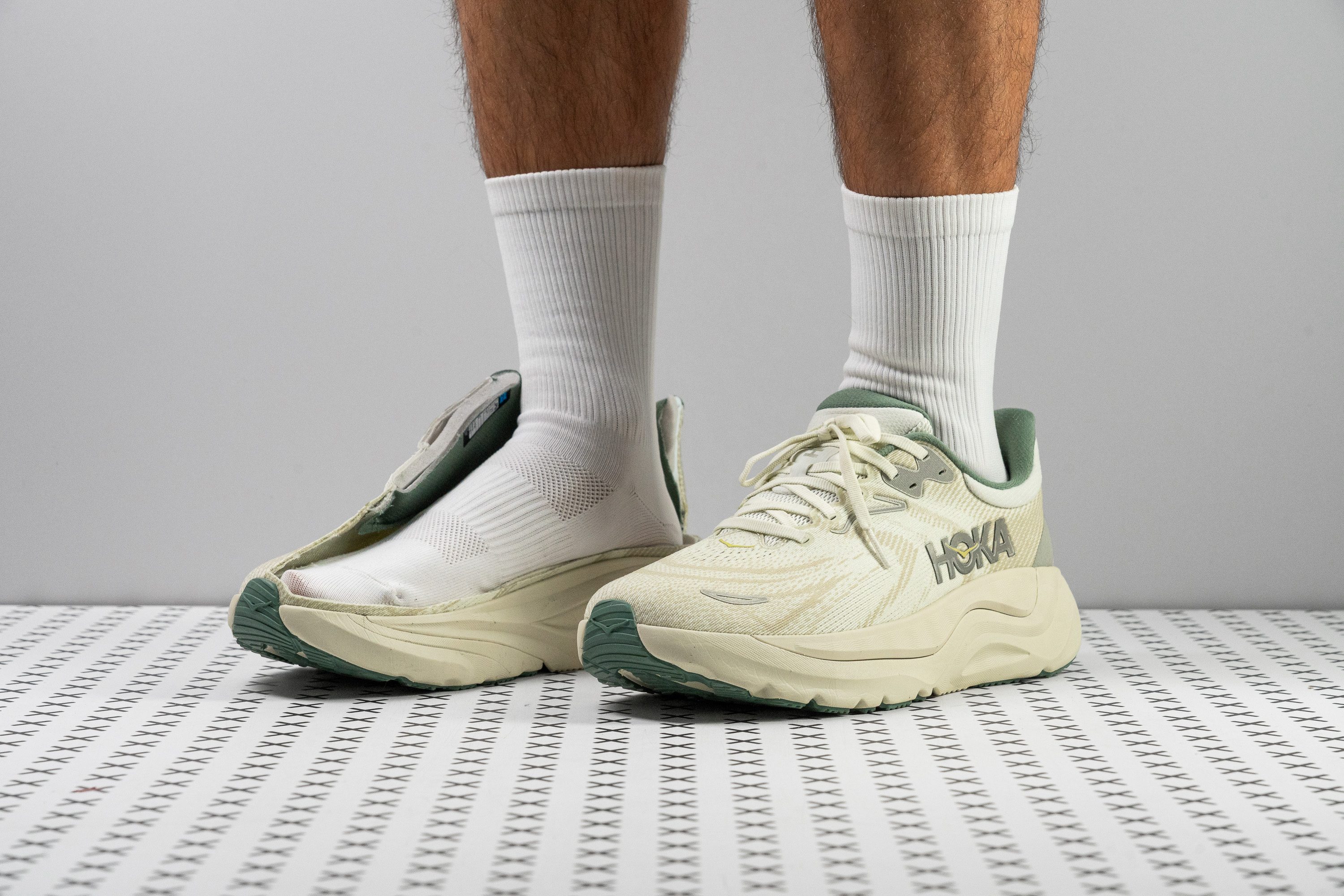











































What makes it the best?
Hoka Arahi 8 is a low-key stability shoe offering gentle support. It’s tailor-made to accommodate low arches and overpronators through its wide and stiff midsole. Through lab tests and runs, we crown it as the best lightweight trainer among low-arch shoes.
One thing struck us as soon as we wore this shoe: it's surprisingly light! At a sleek 9.1 oz (259g), it’s much lighter than the 10.3 oz (293g) average stability shoe.
Striking the middle ground between comfort and support, it has an impact-absorbing base with the rigid H-Frame technology. This framework adds structure to the shoe so that it doesn’t give in to excessive lateral motions and ankle twists, proven by its maximum 5/5 torsional rigidity score.
Meanwhile, it offers supreme cushioning through its tall 39.4/28.1 mm stack, which offers exceptional shock absorption. Our lab results show it’s able to reduce the impact of landing better than average, with high scores of 138 SA in the heel and 113 SA in the forefoot.
Further ensuring a planted sensation is the vast heel. At 96.3 mm, it provides extra room to find our footing, making it a great stability option for rear strikers.
However, its grip is lacking, especially when we encounter wet surfaces. Those seeking top-level traction should skip this pair.
Pros
- Impressively lightweight for its size
- Strong shock absorption
- Wider fit than previous versions
- Outstanding durability across upper and outsole
- Early-Stage Meta Rocker smooths transitions
- Higher drop suits better heel strikers
- Comfy and plush for everyday use
- H-Frame stability system
- Comfortable heel counter
Cons
- Very poor breathability
- Grip needs to improve
- Still no supercritical foam
- Minor price bump
Best daily running shoes for low arches
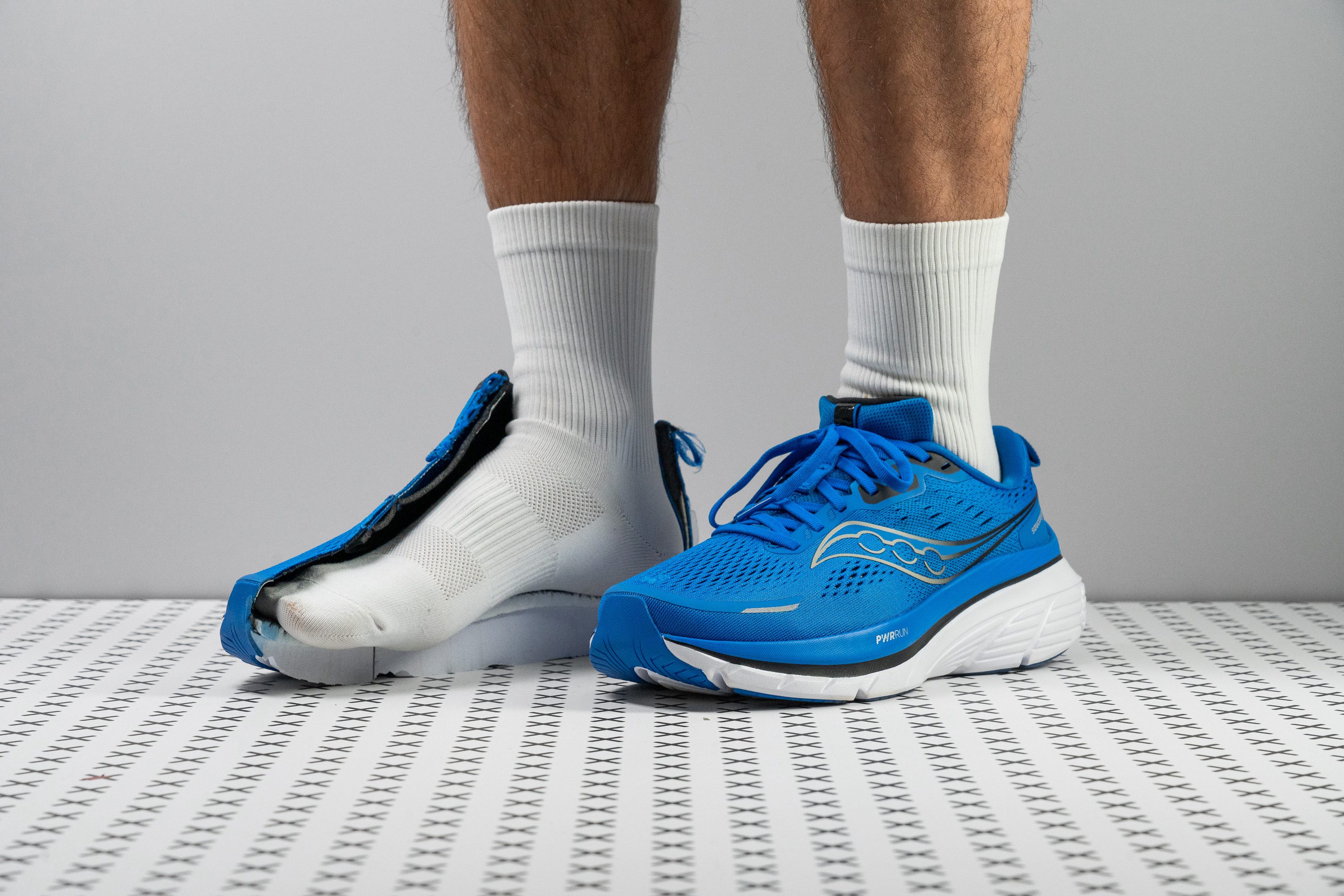















































What makes it the best?
Saucony Guide 18 is our top daily trainer for low arches, providing low-key guidance despite its light, loose, and cushioned midsole. Our lab tests show it blends traditional and contemporary elements to redefine the conventional stability shoe, providing stability without overwhelming force.
The first thing that amazed us is its light weight since stability shoes tend to be heavy. Sitting at 9.8 oz (278g), it beats the 10.1 oz (286g) average of its counterparts. What’s also surprising is how light it feels despite its towering 36.0/27.7 mm stack.
Guide 18 delivers smoother mid-to-forefoot transitions with its rocker geometry. While stability shoes tend to be stiff, it's 8.9% more flexible than the average running shoe, which adds to its comfort and versatility. It feels easy to maneuver since we can stride with our natural form.
The underlying support lies in the balanced and broad midsole and its subtle guiding features. Our durometer reveals the cushion is a balanced 23.0 HA, supporting our arches and absorbing impact. To ensure steady landings, Guide 18 adds width to its 121.9/105.0 mm base (vs. the 114.1/90.7 mm average). The midsole sidewalls and heel flare contribute to locking our feet down for a well-planted feeling.
However, Guide 18 leaves too much foam exposed, sacrificing the shoe’s grip and longevity. Those seeking a robust outsole that can handle wet surfaces and long mileage should check elsewhere.
Pros
- Upper now has exceptional breathability
- Stable yet non-restrictive ride
- Cushioned enough for long runs
- Handles walking too
- Impressively wide platform
- PWRRUN PB insole
- Secure and comfortable lockdown
- Excellent heel rocker design
Cons
- Too much exposed foam on outsole
- Feels bulky and not agile
- Midsole runs a bit firm
Best running shoes for wide feet and low arches
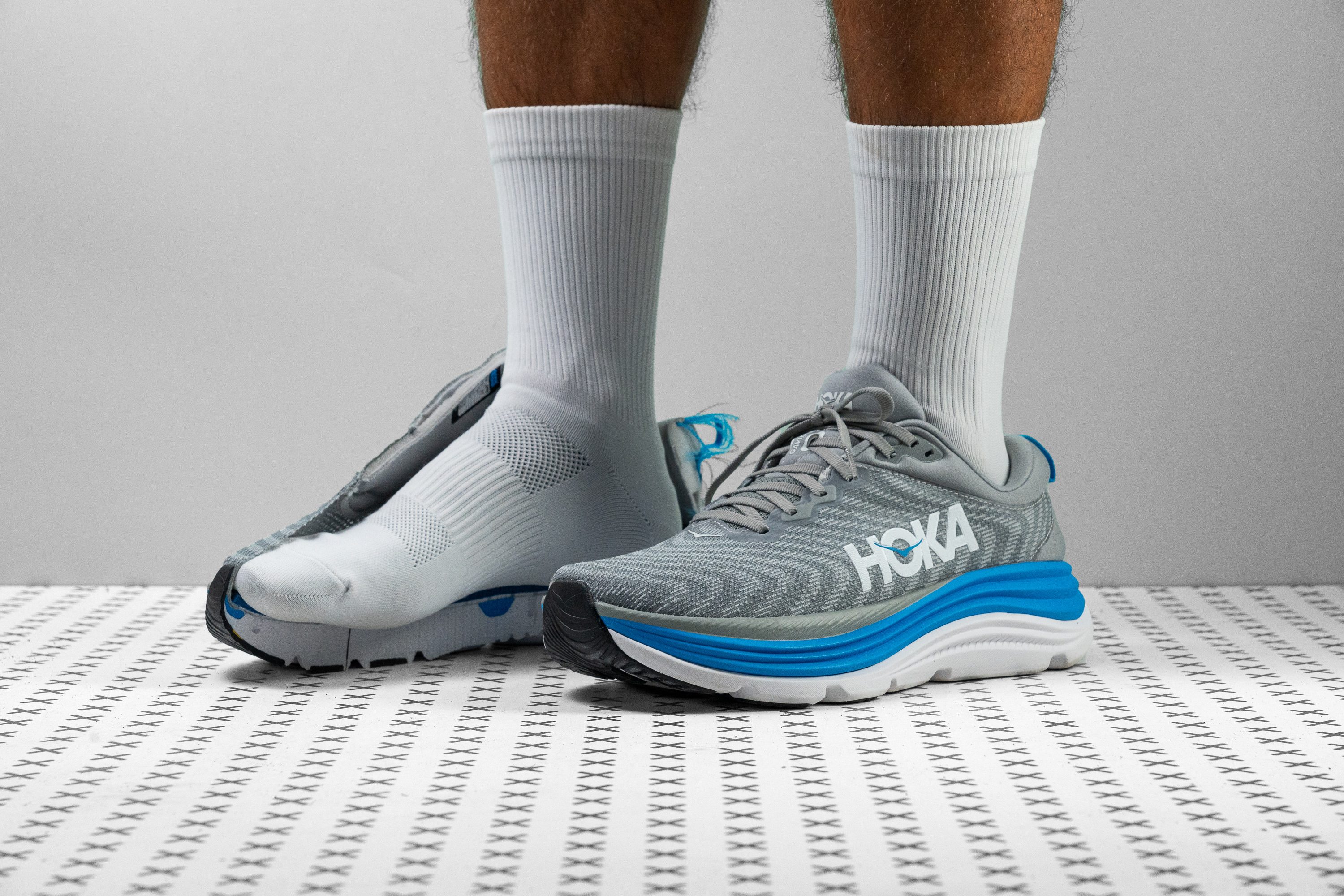

















































What makes it the best?
Multiple tests in and out of the lab allowed us to discover the best low-arch running shoe for wide feet: Hoka Gaviota 5. It provides supreme comfort and unwavering support suited for those who need extra stability and arch support. It has a dual-density foam setup, an exceptionally wide base, and an unobstructed upper that improves the overall running experience.
We felt like we could run endlessly with Gaviota's cushioned and leg-saving ride. Our numbers reveal a generous amount of protection underneath no matter where we land. Its plush 12.9 HA midsole vs. the 23.5 HA average ensures comfort, while the firmer 22.0 HA foam in high-impact areas enhances stable strides.
The remarkably wide landing base, measuring 125.1/106.6 mm in the forefoot and heel, accommodates wide feet with ease because it provides an astounding 11.7/16.3 mm of additional space than average. Further guiding our foot alignment is the H-Frame that keeps us stable laterally.
Our feet never felt trapped in this shoe because of the spacious toebox and breezy upper. The toebox promotes natural toe splay, while the engineered mesh upper has ventilation holes for optimal airflow. Our breathability test confirms this with a well-deserved 5/5 rating.
As expected of a cushioned stability shoe, the Gaviota 5 weighed us down during quicker paces with its 10.6 oz (299g) build vs. the 9.4 oz (266g) average.
Pros
- Remarkably stable
- Breathable and comfortable upper
- Lightweight for its size
- Good stability option for forefoot strikers
- Ideal for wide feet
- Excellent for long runs
Cons
- Low drop might pose issues for heel strikers
- Performs poorly in colder conditions
- Not for narrow feet
- Midsole feels flat
Best budget running shoes for low arches
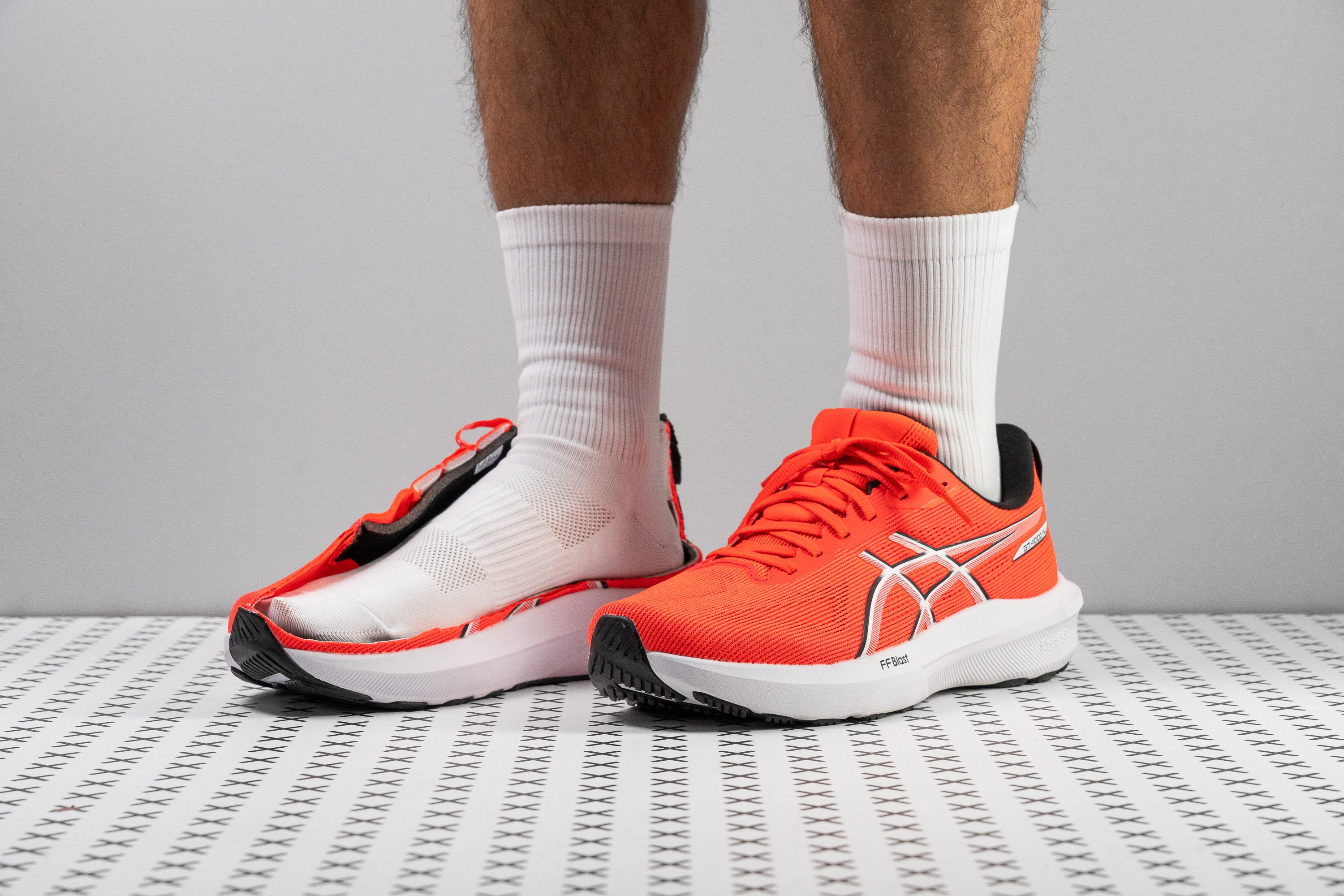













































What makes it the best?
Stability shoes in our lab average $142 upon release, while ASICS GT 1000 14 offers the same support—with much more comfort—for the affordable price of $110. Unfazed by the standard, this shoe excels in natural movement, durability, and surprising lightness. We’re confident this is the best budget low-arch running shoe.
This pair delivers reliable support through smart designs such as its 3D Guidance System, stiffer arch structure, and wide heel, which our caliper confirms at 94.8 mm. The subtle guidance doesn’t feel obtrusive since the midsole feels very fluid. Our flex test validates it’s 18.0% more flexible than average.
The outsole delivers grip without sacrificing durability. It maintains the equilibrium through its high 0.50 traction score in our lab test, while showing 30.0% less wear than average in our Dremel test. It proves that one quality doesn’t have to sacrifice the other!
Light in the pocket and on the feet, it weighs 9.6 oz (272g). A pleasant surprise since most stability shoes weigh above 10.0 oz (283g).
However, GT 1000 14 traps heat with its engineered mesh upper, so we can’t recommend this pair to runners in warm conditions.
Pros
- Supercharged stability
- Ideal for heel strikers
- Still offers amazing value
- Fuss-free, durable design
- Improved outsole traction
- Comfortable for everyday wear
- Great step-in feel
- Improved foam from v13
Cons
- Bad breathability
- Still lacks energy return
- Boring ride


